Early Childhood Education: Inclusion in NSW Australia
VerifiedAdded on 2022/12/27
|13
|2851
|1
Essay
AI Summary
This essay examines the significance of inclusive education for children with disabilities in early childhood settings within New South Wales (NSW), Australia. It highlights the role and importance of supporting the inclusion of all children, emphasizing the benefits for both children with and without disabilities, and the alignment with human rights. The essay analyzes the strength-based approach (SBA) as a method to support inclusion, emphasizing its focus on identifying and building upon children's existing strengths. It then discusses the importance of a team-based approach, highlighting the roles of teachers, parents, and other professionals in creating effective inclusive environments. The essay concludes by summarizing the benefits of inclusive settings for children with disabilities, focusing on cognitive and sensory development, and the importance of tailoring educational plans to individual needs to improve outcomes.
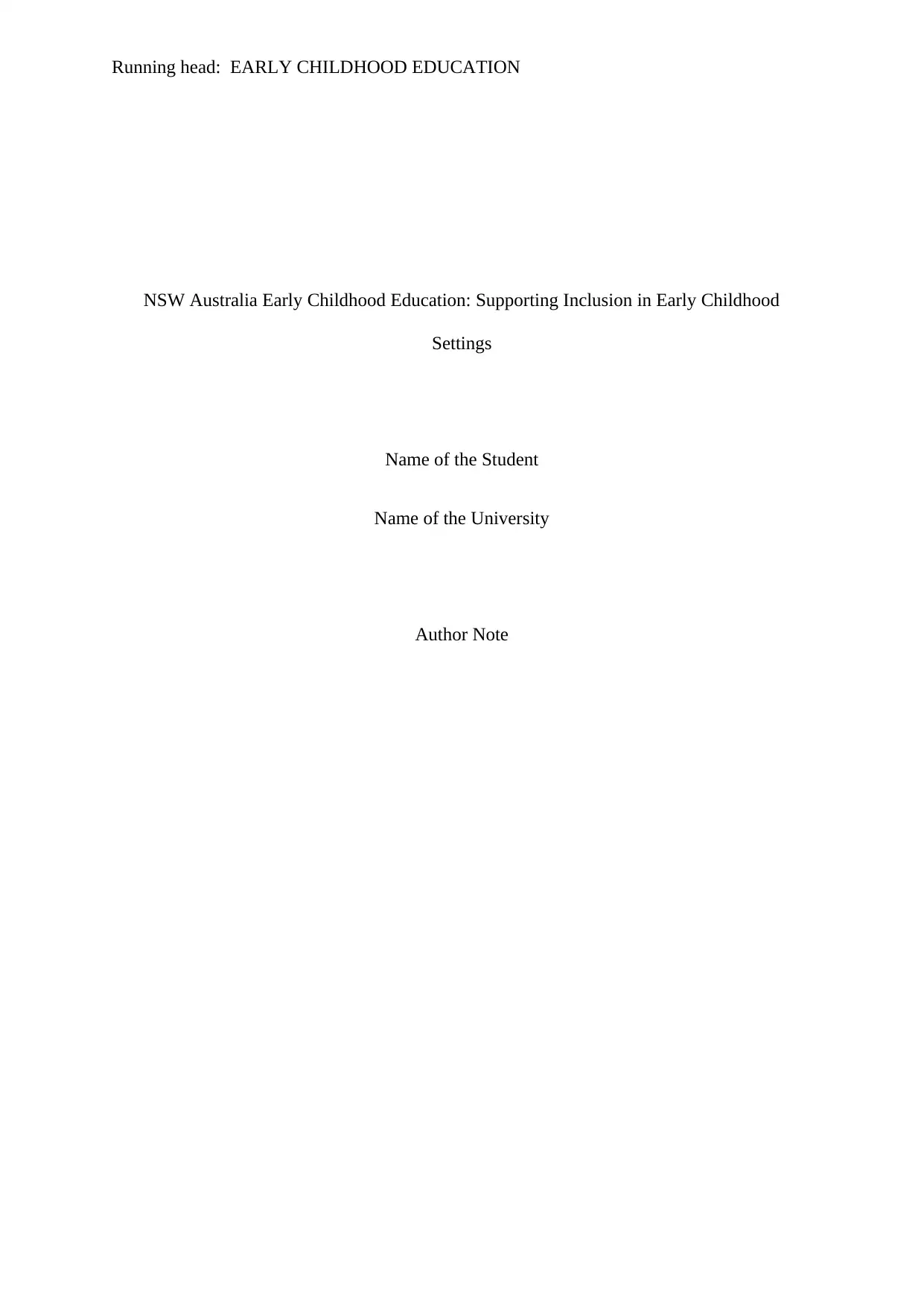
Running head: EARLY CHILDHOOD EDUCATION
NSW Australia Early Childhood Education: Supporting Inclusion in Early Childhood
Settings
Name of the Student
Name of the University
Author Note
NSW Australia Early Childhood Education: Supporting Inclusion in Early Childhood
Settings
Name of the Student
Name of the University
Author Note
Paraphrase This Document
Need a fresh take? Get an instant paraphrase of this document with our AI Paraphraser
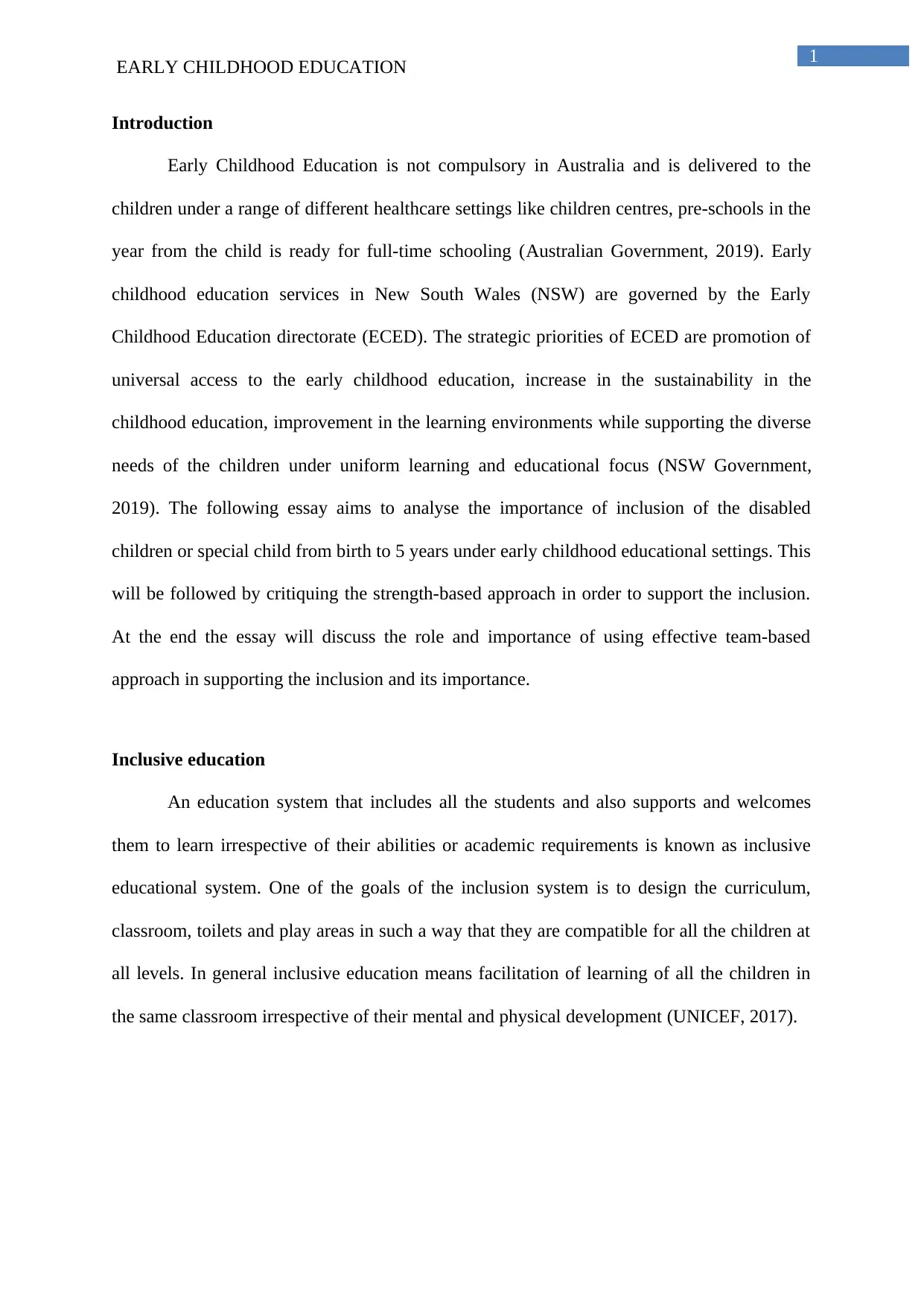
1
EARLY CHILDHOOD EDUCATION
Introduction
Early Childhood Education is not compulsory in Australia and is delivered to the
children under a range of different healthcare settings like children centres, pre-schools in the
year from the child is ready for full-time schooling (Australian Government, 2019). Early
childhood education services in New South Wales (NSW) are governed by the Early
Childhood Education directorate (ECED). The strategic priorities of ECED are promotion of
universal access to the early childhood education, increase in the sustainability in the
childhood education, improvement in the learning environments while supporting the diverse
needs of the children under uniform learning and educational focus (NSW Government,
2019). The following essay aims to analyse the importance of inclusion of the disabled
children or special child from birth to 5 years under early childhood educational settings. This
will be followed by critiquing the strength-based approach in order to support the inclusion.
At the end the essay will discuss the role and importance of using effective team-based
approach in supporting the inclusion and its importance.
Inclusive education
An education system that includes all the students and also supports and welcomes
them to learn irrespective of their abilities or academic requirements is known as inclusive
educational system. One of the goals of the inclusion system is to design the curriculum,
classroom, toilets and play areas in such a way that they are compatible for all the children at
all levels. In general inclusive education means facilitation of learning of all the children in
the same classroom irrespective of their mental and physical development (UNICEF, 2017).
EARLY CHILDHOOD EDUCATION
Introduction
Early Childhood Education is not compulsory in Australia and is delivered to the
children under a range of different healthcare settings like children centres, pre-schools in the
year from the child is ready for full-time schooling (Australian Government, 2019). Early
childhood education services in New South Wales (NSW) are governed by the Early
Childhood Education directorate (ECED). The strategic priorities of ECED are promotion of
universal access to the early childhood education, increase in the sustainability in the
childhood education, improvement in the learning environments while supporting the diverse
needs of the children under uniform learning and educational focus (NSW Government,
2019). The following essay aims to analyse the importance of inclusion of the disabled
children or special child from birth to 5 years under early childhood educational settings. This
will be followed by critiquing the strength-based approach in order to support the inclusion.
At the end the essay will discuss the role and importance of using effective team-based
approach in supporting the inclusion and its importance.
Inclusive education
An education system that includes all the students and also supports and welcomes
them to learn irrespective of their abilities or academic requirements is known as inclusive
educational system. One of the goals of the inclusion system is to design the curriculum,
classroom, toilets and play areas in such a way that they are compatible for all the children at
all levels. In general inclusive education means facilitation of learning of all the children in
the same classroom irrespective of their mental and physical development (UNICEF, 2017).
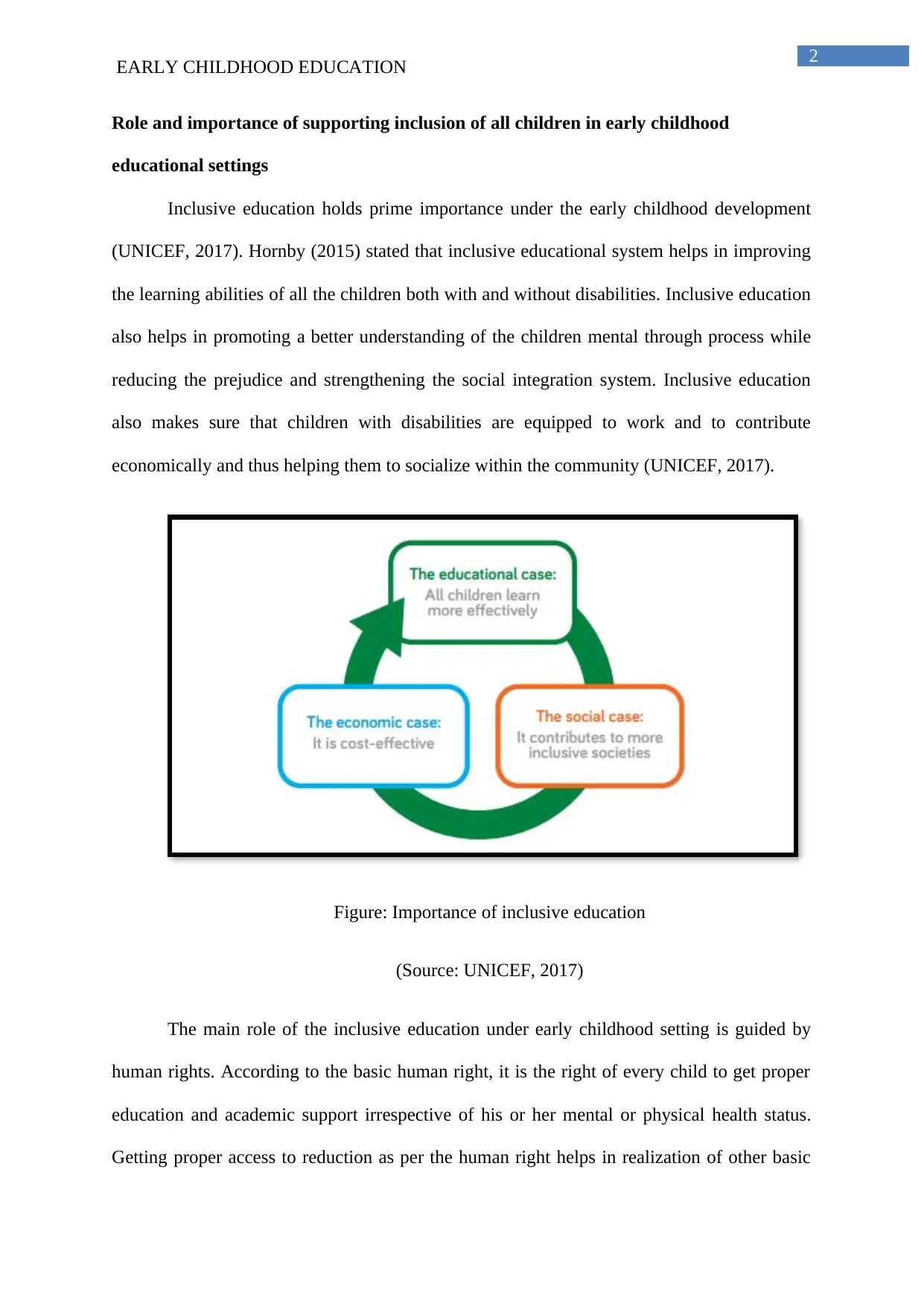
2
EARLY CHILDHOOD EDUCATION
Role and importance of supporting inclusion of all children in early childhood
educational settings
Inclusive education holds prime importance under the early childhood development
(UNICEF, 2017). Hornby (2015) stated that inclusive educational system helps in improving
the learning abilities of all the children both with and without disabilities. Inclusive education
also helps in promoting a better understanding of the children mental through process while
reducing the prejudice and strengthening the social integration system. Inclusive education
also makes sure that children with disabilities are equipped to work and to contribute
economically and thus helping them to socialize within the community (UNICEF, 2017).
Figure: Importance of inclusive education
(Source: UNICEF, 2017)
The main role of the inclusive education under early childhood setting is guided by
human rights. According to the basic human right, it is the right of every child to get proper
education and academic support irrespective of his or her mental or physical health status.
Getting proper access to reduction as per the human right helps in realization of other basic
EARLY CHILDHOOD EDUCATION
Role and importance of supporting inclusion of all children in early childhood
educational settings
Inclusive education holds prime importance under the early childhood development
(UNICEF, 2017). Hornby (2015) stated that inclusive educational system helps in improving
the learning abilities of all the children both with and without disabilities. Inclusive education
also helps in promoting a better understanding of the children mental through process while
reducing the prejudice and strengthening the social integration system. Inclusive education
also makes sure that children with disabilities are equipped to work and to contribute
economically and thus helping them to socialize within the community (UNICEF, 2017).
Figure: Importance of inclusive education
(Source: UNICEF, 2017)
The main role of the inclusive education under early childhood setting is guided by
human rights. According to the basic human right, it is the right of every child to get proper
education and academic support irrespective of his or her mental or physical health status.
Getting proper access to reduction as per the human right helps in realization of other basic
⊘ This is a preview!⊘
Do you want full access?
Subscribe today to unlock all pages.

Trusted by 1+ million students worldwide
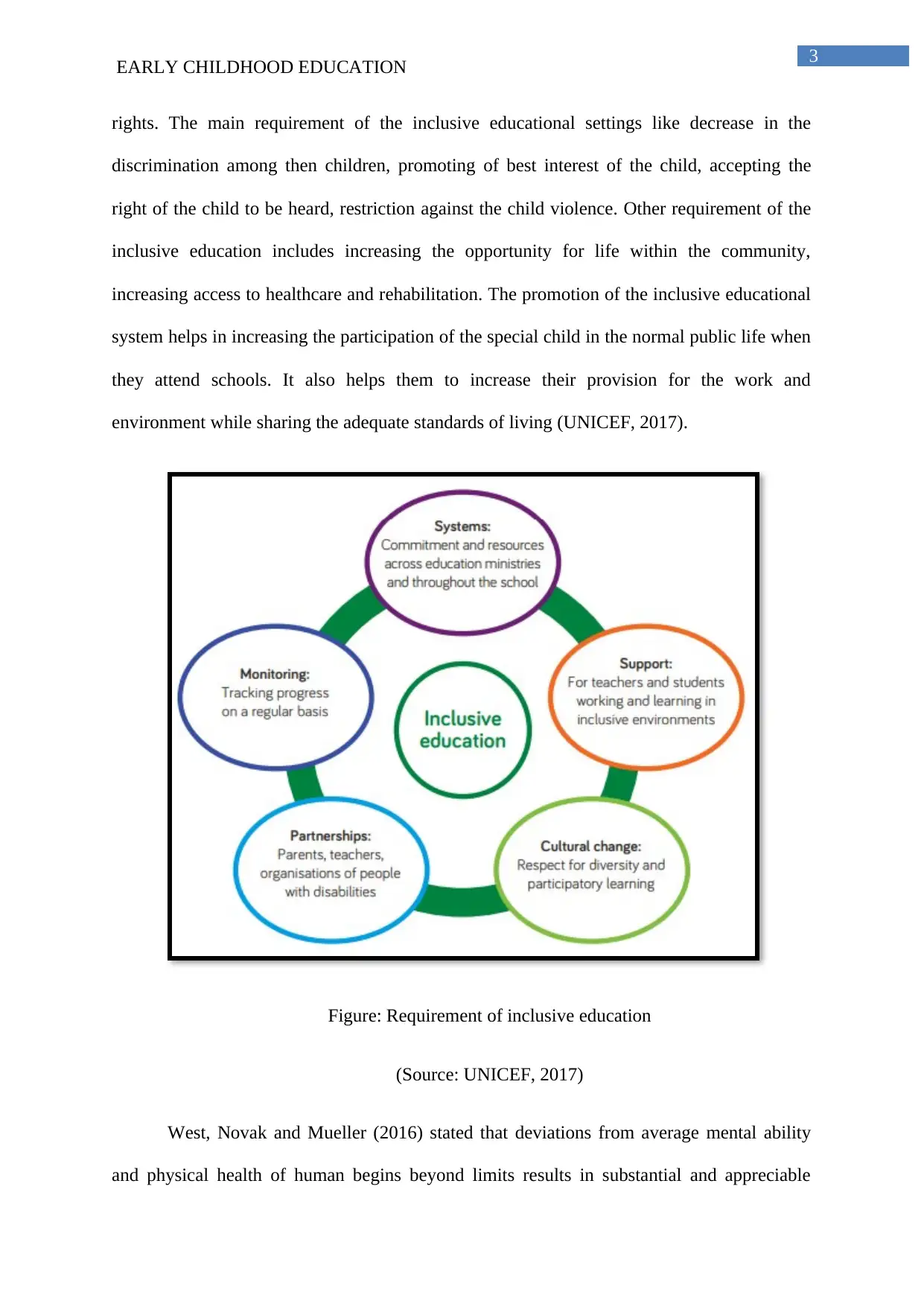
3
EARLY CHILDHOOD EDUCATION
rights. The main requirement of the inclusive educational settings like decrease in the
discrimination among then children, promoting of best interest of the child, accepting the
right of the child to be heard, restriction against the child violence. Other requirement of the
inclusive education includes increasing the opportunity for life within the community,
increasing access to healthcare and rehabilitation. The promotion of the inclusive educational
system helps in increasing the participation of the special child in the normal public life when
they attend schools. It also helps them to increase their provision for the work and
environment while sharing the adequate standards of living (UNICEF, 2017).
Figure: Requirement of inclusive education
(Source: UNICEF, 2017)
West, Novak and Mueller (2016) stated that deviations from average mental ability
and physical health of human begins beyond limits results in substantial and appreciable
EARLY CHILDHOOD EDUCATION
rights. The main requirement of the inclusive educational settings like decrease in the
discrimination among then children, promoting of best interest of the child, accepting the
right of the child to be heard, restriction against the child violence. Other requirement of the
inclusive education includes increasing the opportunity for life within the community,
increasing access to healthcare and rehabilitation. The promotion of the inclusive educational
system helps in increasing the participation of the special child in the normal public life when
they attend schools. It also helps them to increase their provision for the work and
environment while sharing the adequate standards of living (UNICEF, 2017).
Figure: Requirement of inclusive education
(Source: UNICEF, 2017)
West, Novak and Mueller (2016) stated that deviations from average mental ability
and physical health of human begins beyond limits results in substantial and appreciable
Paraphrase This Document
Need a fresh take? Get an instant paraphrase of this document with our AI Paraphraser
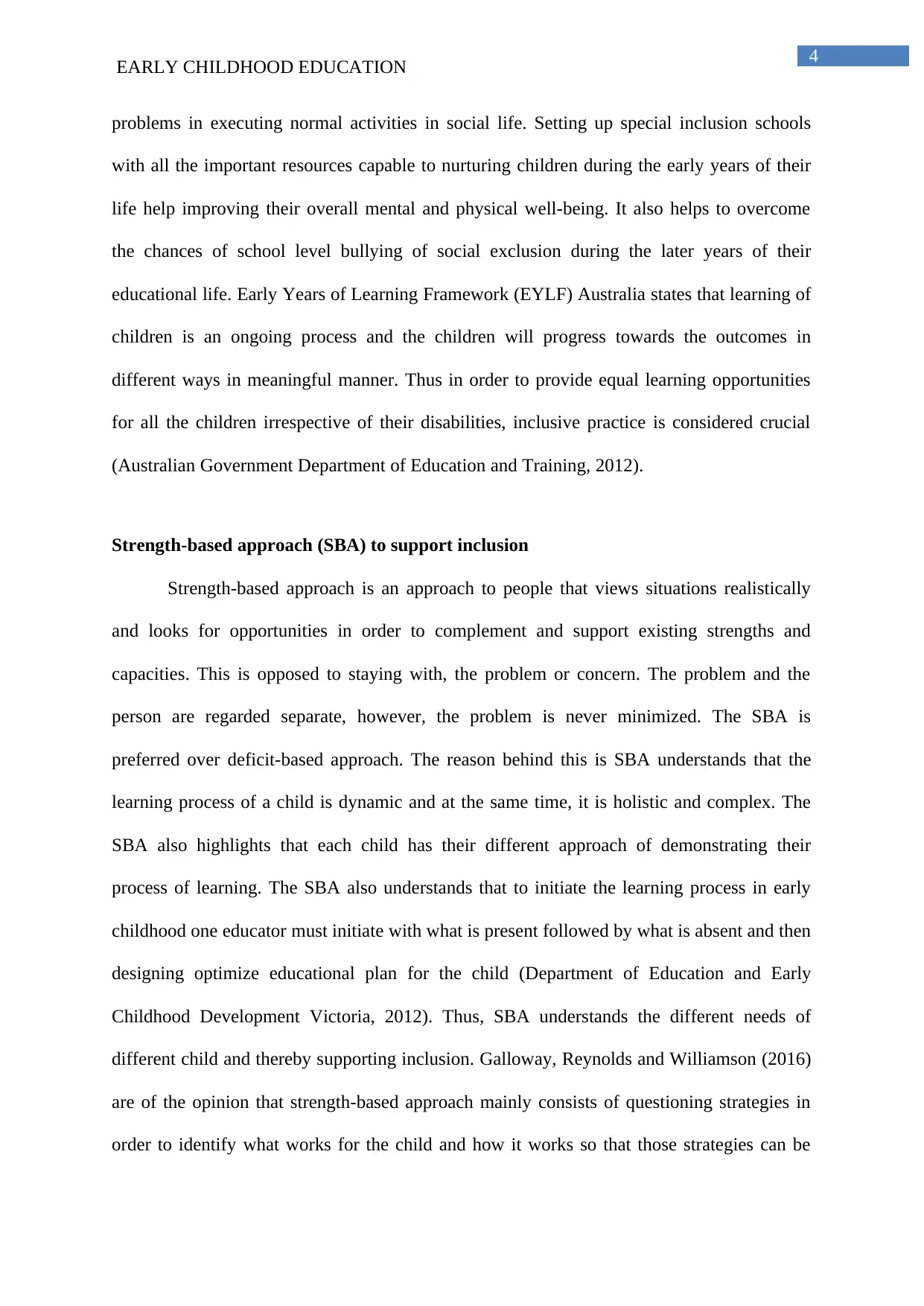
4
EARLY CHILDHOOD EDUCATION
problems in executing normal activities in social life. Setting up special inclusion schools
with all the important resources capable to nurturing children during the early years of their
life help improving their overall mental and physical well-being. It also helps to overcome
the chances of school level bullying of social exclusion during the later years of their
educational life. Early Years of Learning Framework (EYLF) Australia states that learning of
children is an ongoing process and the children will progress towards the outcomes in
different ways in meaningful manner. Thus in order to provide equal learning opportunities
for all the children irrespective of their disabilities, inclusive practice is considered crucial
(Australian Government Department of Education and Training, 2012).
Strength-based approach (SBA) to support inclusion
Strength-based approach is an approach to people that views situations realistically
and looks for opportunities in order to complement and support existing strengths and
capacities. This is opposed to staying with, the problem or concern. The problem and the
person are regarded separate, however, the problem is never minimized. The SBA is
preferred over deficit-based approach. The reason behind this is SBA understands that the
learning process of a child is dynamic and at the same time, it is holistic and complex. The
SBA also highlights that each child has their different approach of demonstrating their
process of learning. The SBA also understands that to initiate the learning process in early
childhood one educator must initiate with what is present followed by what is absent and then
designing optimize educational plan for the child (Department of Education and Early
Childhood Development Victoria, 2012). Thus, SBA understands the different needs of
different child and thereby supporting inclusion. Galloway, Reynolds and Williamson (2016)
are of the opinion that strength-based approach mainly consists of questioning strategies in
order to identify what works for the child and how it works so that those strategies can be
EARLY CHILDHOOD EDUCATION
problems in executing normal activities in social life. Setting up special inclusion schools
with all the important resources capable to nurturing children during the early years of their
life help improving their overall mental and physical well-being. It also helps to overcome
the chances of school level bullying of social exclusion during the later years of their
educational life. Early Years of Learning Framework (EYLF) Australia states that learning of
children is an ongoing process and the children will progress towards the outcomes in
different ways in meaningful manner. Thus in order to provide equal learning opportunities
for all the children irrespective of their disabilities, inclusive practice is considered crucial
(Australian Government Department of Education and Training, 2012).
Strength-based approach (SBA) to support inclusion
Strength-based approach is an approach to people that views situations realistically
and looks for opportunities in order to complement and support existing strengths and
capacities. This is opposed to staying with, the problem or concern. The problem and the
person are regarded separate, however, the problem is never minimized. The SBA is
preferred over deficit-based approach. The reason behind this is SBA understands that the
learning process of a child is dynamic and at the same time, it is holistic and complex. The
SBA also highlights that each child has their different approach of demonstrating their
process of learning. The SBA also understands that to initiate the learning process in early
childhood one educator must initiate with what is present followed by what is absent and then
designing optimize educational plan for the child (Department of Education and Early
Childhood Development Victoria, 2012). Thus, SBA understands the different needs of
different child and thereby supporting inclusion. Galloway, Reynolds and Williamson (2016)
are of the opinion that strength-based approach mainly consists of questioning strategies in
order to identify what works for the child and how it works so that those strategies can be
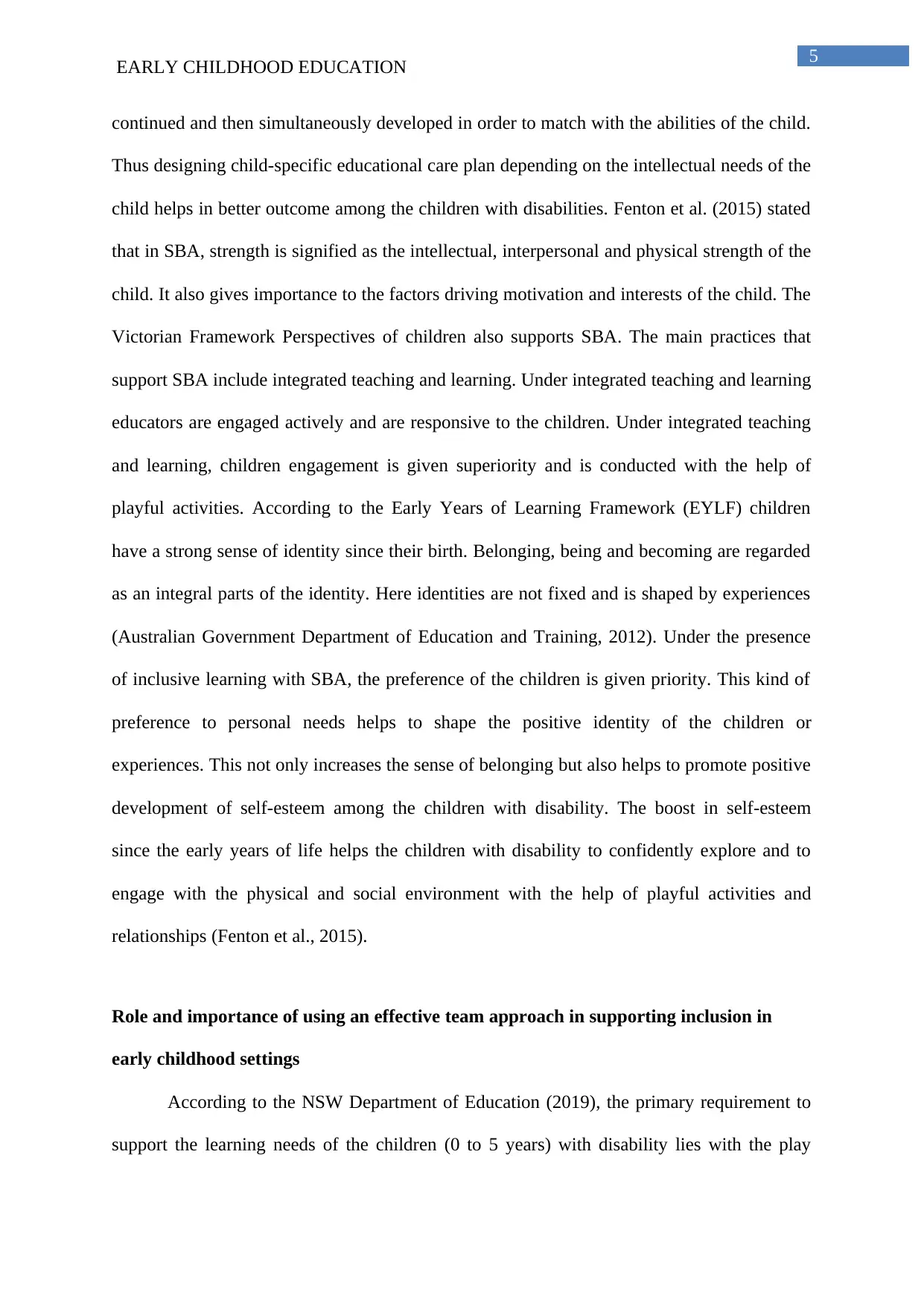
5
EARLY CHILDHOOD EDUCATION
continued and then simultaneously developed in order to match with the abilities of the child.
Thus designing child-specific educational care plan depending on the intellectual needs of the
child helps in better outcome among the children with disabilities. Fenton et al. (2015) stated
that in SBA, strength is signified as the intellectual, interpersonal and physical strength of the
child. It also gives importance to the factors driving motivation and interests of the child. The
Victorian Framework Perspectives of children also supports SBA. The main practices that
support SBA include integrated teaching and learning. Under integrated teaching and learning
educators are engaged actively and are responsive to the children. Under integrated teaching
and learning, children engagement is given superiority and is conducted with the help of
playful activities. According to the Early Years of Learning Framework (EYLF) children
have a strong sense of identity since their birth. Belonging, being and becoming are regarded
as an integral parts of the identity. Here identities are not fixed and is shaped by experiences
(Australian Government Department of Education and Training, 2012). Under the presence
of inclusive learning with SBA, the preference of the children is given priority. This kind of
preference to personal needs helps to shape the positive identity of the children or
experiences. This not only increases the sense of belonging but also helps to promote positive
development of self-esteem among the children with disability. The boost in self-esteem
since the early years of life helps the children with disability to confidently explore and to
engage with the physical and social environment with the help of playful activities and
relationships (Fenton et al., 2015).
Role and importance of using an effective team approach in supporting inclusion in
early childhood settings
According to the NSW Department of Education (2019), the primary requirement to
support the learning needs of the children (0 to 5 years) with disability lies with the play
EARLY CHILDHOOD EDUCATION
continued and then simultaneously developed in order to match with the abilities of the child.
Thus designing child-specific educational care plan depending on the intellectual needs of the
child helps in better outcome among the children with disabilities. Fenton et al. (2015) stated
that in SBA, strength is signified as the intellectual, interpersonal and physical strength of the
child. It also gives importance to the factors driving motivation and interests of the child. The
Victorian Framework Perspectives of children also supports SBA. The main practices that
support SBA include integrated teaching and learning. Under integrated teaching and learning
educators are engaged actively and are responsive to the children. Under integrated teaching
and learning, children engagement is given superiority and is conducted with the help of
playful activities. According to the Early Years of Learning Framework (EYLF) children
have a strong sense of identity since their birth. Belonging, being and becoming are regarded
as an integral parts of the identity. Here identities are not fixed and is shaped by experiences
(Australian Government Department of Education and Training, 2012). Under the presence
of inclusive learning with SBA, the preference of the children is given priority. This kind of
preference to personal needs helps to shape the positive identity of the children or
experiences. This not only increases the sense of belonging but also helps to promote positive
development of self-esteem among the children with disability. The boost in self-esteem
since the early years of life helps the children with disability to confidently explore and to
engage with the physical and social environment with the help of playful activities and
relationships (Fenton et al., 2015).
Role and importance of using an effective team approach in supporting inclusion in
early childhood settings
According to the NSW Department of Education (2019), the primary requirement to
support the learning needs of the children (0 to 5 years) with disability lies with the play
⊘ This is a preview!⊘
Do you want full access?
Subscribe today to unlock all pages.

Trusted by 1+ million students worldwide
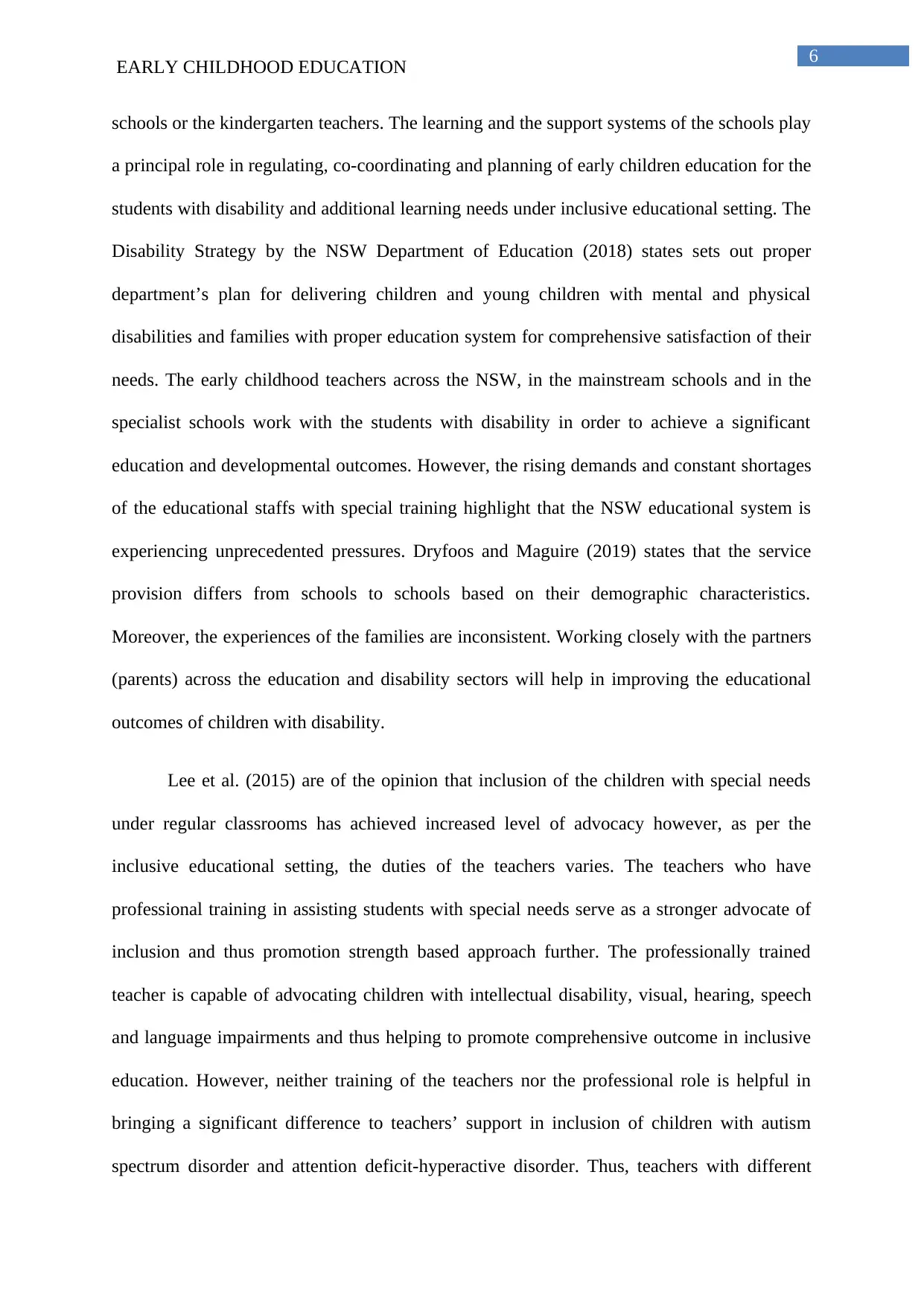
6
EARLY CHILDHOOD EDUCATION
schools or the kindergarten teachers. The learning and the support systems of the schools play
a principal role in regulating, co-coordinating and planning of early children education for the
students with disability and additional learning needs under inclusive educational setting. The
Disability Strategy by the NSW Department of Education (2018) states sets out proper
department’s plan for delivering children and young children with mental and physical
disabilities and families with proper education system for comprehensive satisfaction of their
needs. The early childhood teachers across the NSW, in the mainstream schools and in the
specialist schools work with the students with disability in order to achieve a significant
education and developmental outcomes. However, the rising demands and constant shortages
of the educational staffs with special training highlight that the NSW educational system is
experiencing unprecedented pressures. Dryfoos and Maguire (2019) states that the service
provision differs from schools to schools based on their demographic characteristics.
Moreover, the experiences of the families are inconsistent. Working closely with the partners
(parents) across the education and disability sectors will help in improving the educational
outcomes of children with disability.
Lee et al. (2015) are of the opinion that inclusion of the children with special needs
under regular classrooms has achieved increased level of advocacy however, as per the
inclusive educational setting, the duties of the teachers varies. The teachers who have
professional training in assisting students with special needs serve as a stronger advocate of
inclusion and thus promotion strength based approach further. The professionally trained
teacher is capable of advocating children with intellectual disability, visual, hearing, speech
and language impairments and thus helping to promote comprehensive outcome in inclusive
education. However, neither training of the teachers nor the professional role is helpful in
bringing a significant difference to teachers’ support in inclusion of children with autism
spectrum disorder and attention deficit-hyperactive disorder. Thus, teachers with different
EARLY CHILDHOOD EDUCATION
schools or the kindergarten teachers. The learning and the support systems of the schools play
a principal role in regulating, co-coordinating and planning of early children education for the
students with disability and additional learning needs under inclusive educational setting. The
Disability Strategy by the NSW Department of Education (2018) states sets out proper
department’s plan for delivering children and young children with mental and physical
disabilities and families with proper education system for comprehensive satisfaction of their
needs. The early childhood teachers across the NSW, in the mainstream schools and in the
specialist schools work with the students with disability in order to achieve a significant
education and developmental outcomes. However, the rising demands and constant shortages
of the educational staffs with special training highlight that the NSW educational system is
experiencing unprecedented pressures. Dryfoos and Maguire (2019) states that the service
provision differs from schools to schools based on their demographic characteristics.
Moreover, the experiences of the families are inconsistent. Working closely with the partners
(parents) across the education and disability sectors will help in improving the educational
outcomes of children with disability.
Lee et al. (2015) are of the opinion that inclusion of the children with special needs
under regular classrooms has achieved increased level of advocacy however, as per the
inclusive educational setting, the duties of the teachers varies. The teachers who have
professional training in assisting students with special needs serve as a stronger advocate of
inclusion and thus promotion strength based approach further. The professionally trained
teacher is capable of advocating children with intellectual disability, visual, hearing, speech
and language impairments and thus helping to promote comprehensive outcome in inclusive
education. However, neither training of the teachers nor the professional role is helpful in
bringing a significant difference to teachers’ support in inclusion of children with autism
spectrum disorder and attention deficit-hyperactive disorder. Thus, teachers with different
Paraphrase This Document
Need a fresh take? Get an instant paraphrase of this document with our AI Paraphraser
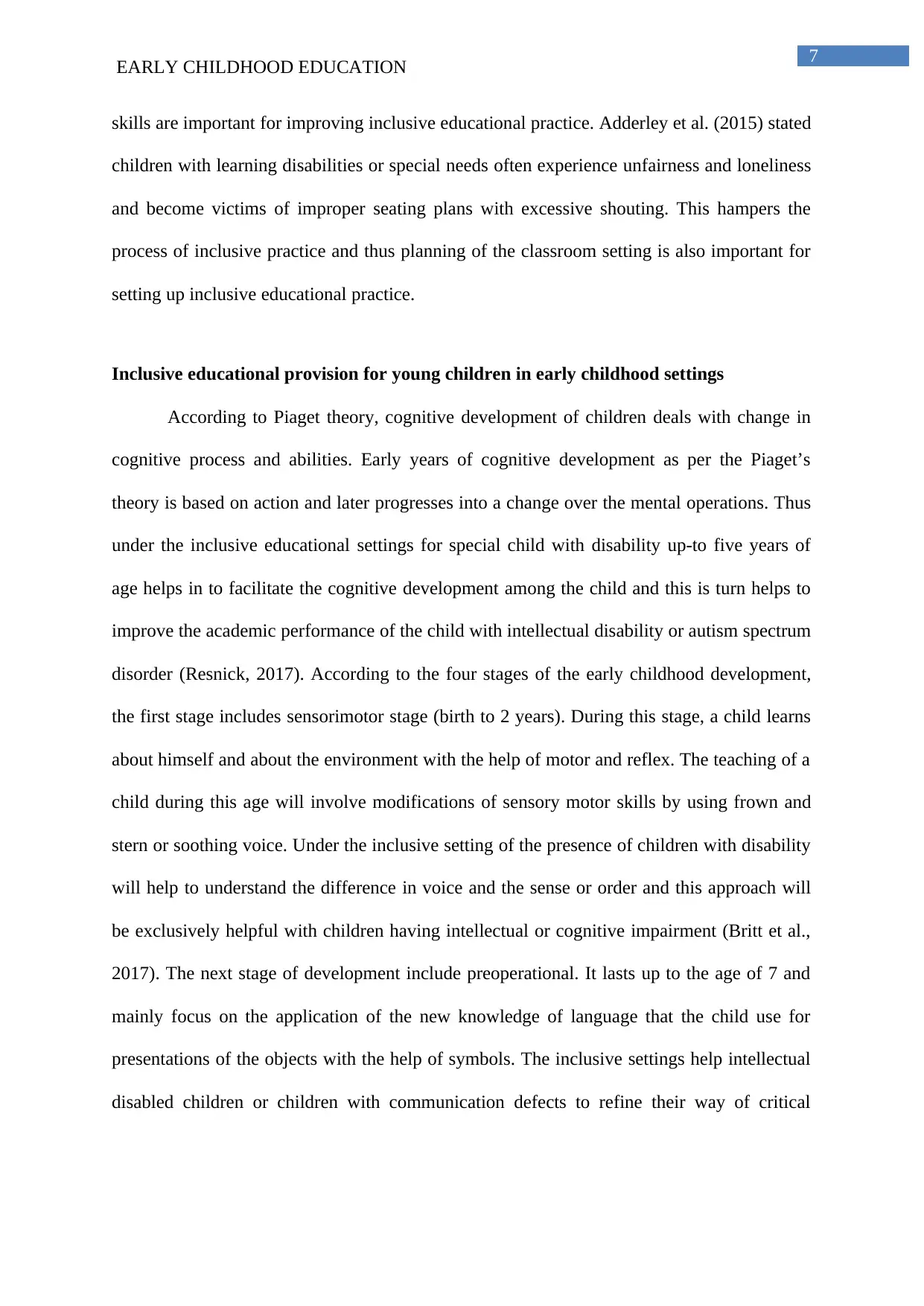
7
EARLY CHILDHOOD EDUCATION
skills are important for improving inclusive educational practice. Adderley et al. (2015) stated
children with learning disabilities or special needs often experience unfairness and loneliness
and become victims of improper seating plans with excessive shouting. This hampers the
process of inclusive practice and thus planning of the classroom setting is also important for
setting up inclusive educational practice.
Inclusive educational provision for young children in early childhood settings
According to Piaget theory, cognitive development of children deals with change in
cognitive process and abilities. Early years of cognitive development as per the Piaget’s
theory is based on action and later progresses into a change over the mental operations. Thus
under the inclusive educational settings for special child with disability up-to five years of
age helps in to facilitate the cognitive development among the child and this is turn helps to
improve the academic performance of the child with intellectual disability or autism spectrum
disorder (Resnick, 2017). According to the four stages of the early childhood development,
the first stage includes sensorimotor stage (birth to 2 years). During this stage, a child learns
about himself and about the environment with the help of motor and reflex. The teaching of a
child during this age will involve modifications of sensory motor skills by using frown and
stern or soothing voice. Under the inclusive setting of the presence of children with disability
will help to understand the difference in voice and the sense or order and this approach will
be exclusively helpful with children having intellectual or cognitive impairment (Britt et al.,
2017). The next stage of development include preoperational. It lasts up to the age of 7 and
mainly focus on the application of the new knowledge of language that the child use for
presentations of the objects with the help of symbols. The inclusive settings help intellectual
disabled children or children with communication defects to refine their way of critical
EARLY CHILDHOOD EDUCATION
skills are important for improving inclusive educational practice. Adderley et al. (2015) stated
children with learning disabilities or special needs often experience unfairness and loneliness
and become victims of improper seating plans with excessive shouting. This hampers the
process of inclusive practice and thus planning of the classroom setting is also important for
setting up inclusive educational practice.
Inclusive educational provision for young children in early childhood settings
According to Piaget theory, cognitive development of children deals with change in
cognitive process and abilities. Early years of cognitive development as per the Piaget’s
theory is based on action and later progresses into a change over the mental operations. Thus
under the inclusive educational settings for special child with disability up-to five years of
age helps in to facilitate the cognitive development among the child and this is turn helps to
improve the academic performance of the child with intellectual disability or autism spectrum
disorder (Resnick, 2017). According to the four stages of the early childhood development,
the first stage includes sensorimotor stage (birth to 2 years). During this stage, a child learns
about himself and about the environment with the help of motor and reflex. The teaching of a
child during this age will involve modifications of sensory motor skills by using frown and
stern or soothing voice. Under the inclusive setting of the presence of children with disability
will help to understand the difference in voice and the sense or order and this approach will
be exclusively helpful with children having intellectual or cognitive impairment (Britt et al.,
2017). The next stage of development include preoperational. It lasts up to the age of 7 and
mainly focus on the application of the new knowledge of language that the child use for
presentations of the objects with the help of symbols. The inclusive settings help intellectual
disabled children or children with communication defects to refine their way of critical
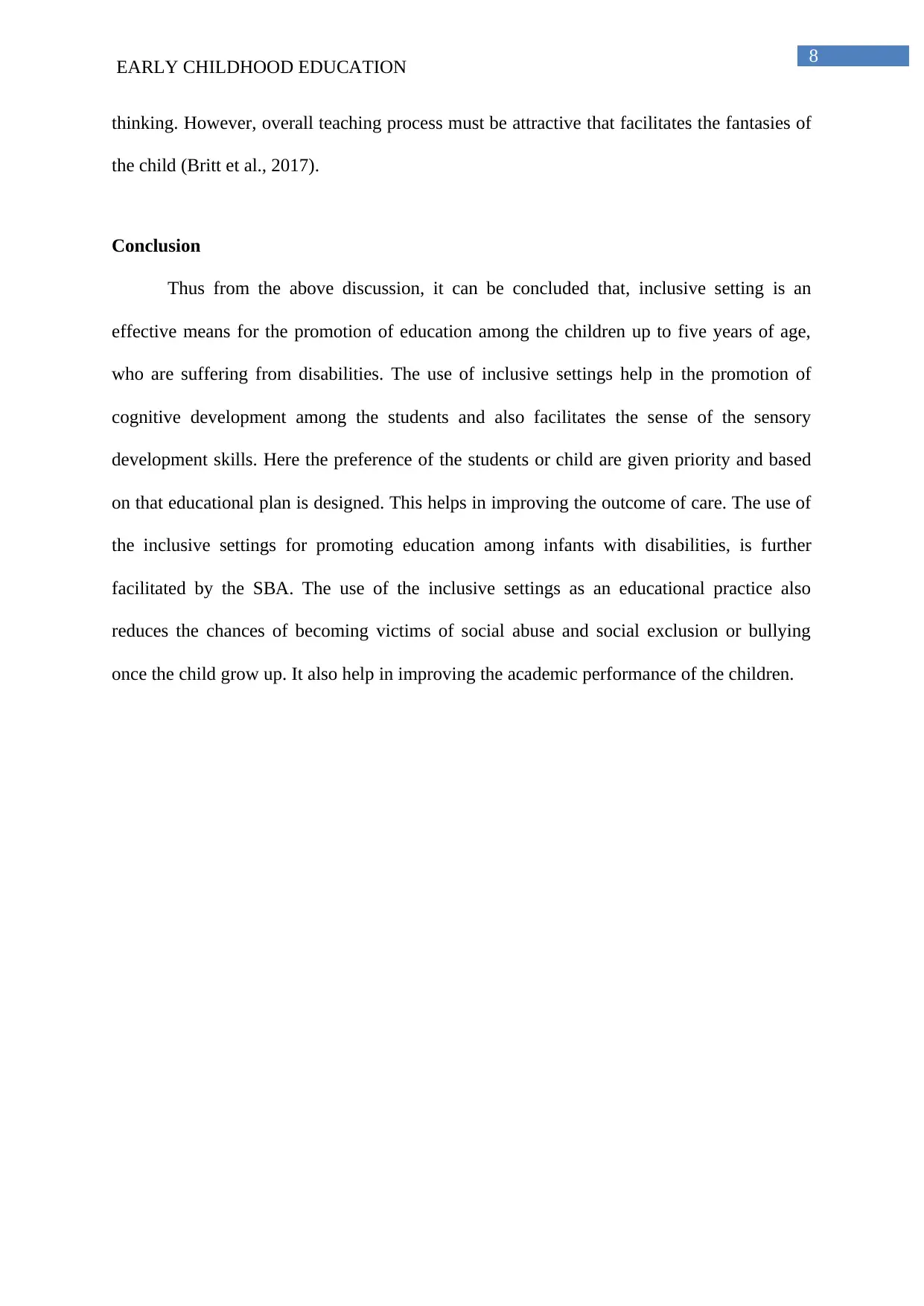
8
EARLY CHILDHOOD EDUCATION
thinking. However, overall teaching process must be attractive that facilitates the fantasies of
the child (Britt et al., 2017).
Conclusion
Thus from the above discussion, it can be concluded that, inclusive setting is an
effective means for the promotion of education among the children up to five years of age,
who are suffering from disabilities. The use of inclusive settings help in the promotion of
cognitive development among the students and also facilitates the sense of the sensory
development skills. Here the preference of the students or child are given priority and based
on that educational plan is designed. This helps in improving the outcome of care. The use of
the inclusive settings for promoting education among infants with disabilities, is further
facilitated by the SBA. The use of the inclusive settings as an educational practice also
reduces the chances of becoming victims of social abuse and social exclusion or bullying
once the child grow up. It also help in improving the academic performance of the children.
EARLY CHILDHOOD EDUCATION
thinking. However, overall teaching process must be attractive that facilitates the fantasies of
the child (Britt et al., 2017).
Conclusion
Thus from the above discussion, it can be concluded that, inclusive setting is an
effective means for the promotion of education among the children up to five years of age,
who are suffering from disabilities. The use of inclusive settings help in the promotion of
cognitive development among the students and also facilitates the sense of the sensory
development skills. Here the preference of the students or child are given priority and based
on that educational plan is designed. This helps in improving the outcome of care. The use of
the inclusive settings for promoting education among infants with disabilities, is further
facilitated by the SBA. The use of the inclusive settings as an educational practice also
reduces the chances of becoming victims of social abuse and social exclusion or bullying
once the child grow up. It also help in improving the academic performance of the children.
⊘ This is a preview!⊘
Do you want full access?
Subscribe today to unlock all pages.

Trusted by 1+ million students worldwide
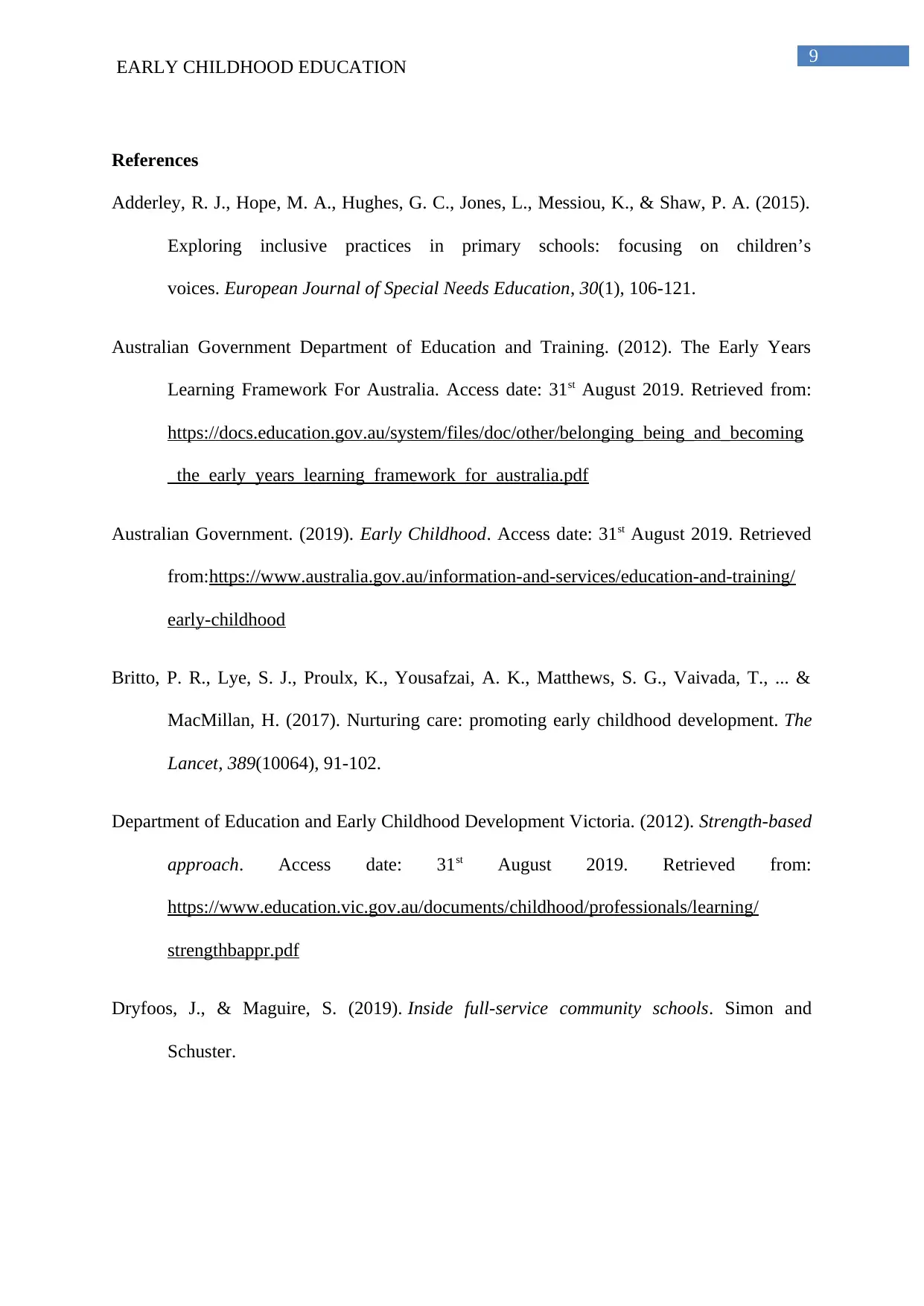
9
EARLY CHILDHOOD EDUCATION
References
Adderley, R. J., Hope, M. A., Hughes, G. C., Jones, L., Messiou, K., & Shaw, P. A. (2015).
Exploring inclusive practices in primary schools: focusing on children’s
voices. European Journal of Special Needs Education, 30(1), 106-121.
Australian Government Department of Education and Training. (2012). The Early Years
Learning Framework For Australia. Access date: 31st August 2019. Retrieved from:
https://docs.education.gov.au/system/files/doc/other/belonging_being_and_becoming
_the_early_years_learning_framework_for_australia.pdf
Australian Government. (2019). Early Childhood. Access date: 31st August 2019. Retrieved
from:https://www.australia.gov.au/information-and-services/education-and-training/
early-childhood
Britto, P. R., Lye, S. J., Proulx, K., Yousafzai, A. K., Matthews, S. G., Vaivada, T., ... &
MacMillan, H. (2017). Nurturing care: promoting early childhood development. The
Lancet, 389(10064), 91-102.
Department of Education and Early Childhood Development Victoria. (2012). Strength-based
approach. Access date: 31st August 2019. Retrieved from:
https://www.education.vic.gov.au/documents/childhood/professionals/learning/
strengthbappr.pdf
Dryfoos, J., & Maguire, S. (2019). Inside full-service community schools. Simon and
Schuster.
EARLY CHILDHOOD EDUCATION
References
Adderley, R. J., Hope, M. A., Hughes, G. C., Jones, L., Messiou, K., & Shaw, P. A. (2015).
Exploring inclusive practices in primary schools: focusing on children’s
voices. European Journal of Special Needs Education, 30(1), 106-121.
Australian Government Department of Education and Training. (2012). The Early Years
Learning Framework For Australia. Access date: 31st August 2019. Retrieved from:
https://docs.education.gov.au/system/files/doc/other/belonging_being_and_becoming
_the_early_years_learning_framework_for_australia.pdf
Australian Government. (2019). Early Childhood. Access date: 31st August 2019. Retrieved
from:https://www.australia.gov.au/information-and-services/education-and-training/
early-childhood
Britto, P. R., Lye, S. J., Proulx, K., Yousafzai, A. K., Matthews, S. G., Vaivada, T., ... &
MacMillan, H. (2017). Nurturing care: promoting early childhood development. The
Lancet, 389(10064), 91-102.
Department of Education and Early Childhood Development Victoria. (2012). Strength-based
approach. Access date: 31st August 2019. Retrieved from:
https://www.education.vic.gov.au/documents/childhood/professionals/learning/
strengthbappr.pdf
Dryfoos, J., & Maguire, S. (2019). Inside full-service community schools. Simon and
Schuster.
Paraphrase This Document
Need a fresh take? Get an instant paraphrase of this document with our AI Paraphraser
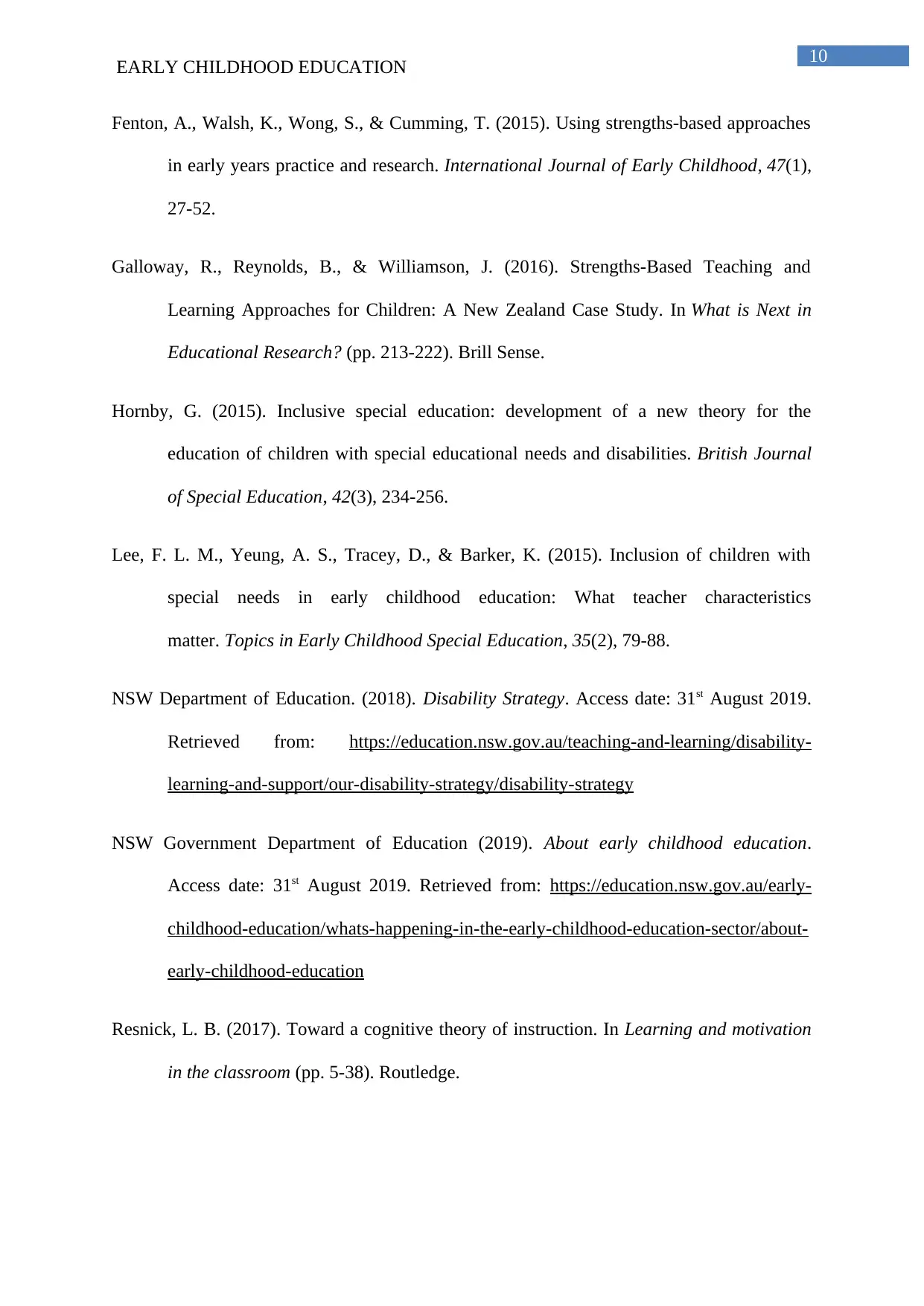
10
EARLY CHILDHOOD EDUCATION
Fenton, A., Walsh, K., Wong, S., & Cumming, T. (2015). Using strengths-based approaches
in early years practice and research. International Journal of Early Childhood, 47(1),
27-52.
Galloway, R., Reynolds, B., & Williamson, J. (2016). Strengths-Based Teaching and
Learning Approaches for Children: A New Zealand Case Study. In What is Next in
Educational Research? (pp. 213-222). Brill Sense.
Hornby, G. (2015). Inclusive special education: development of a new theory for the
education of children with special educational needs and disabilities. British Journal
of Special Education, 42(3), 234-256.
Lee, F. L. M., Yeung, A. S., Tracey, D., & Barker, K. (2015). Inclusion of children with
special needs in early childhood education: What teacher characteristics
matter. Topics in Early Childhood Special Education, 35(2), 79-88.
NSW Department of Education. (2018). Disability Strategy. Access date: 31st August 2019.
Retrieved from: https://education.nsw.gov.au/teaching-and-learning/disability-
learning-and-support/our-disability-strategy/disability-strategy
NSW Government Department of Education (2019). About early childhood education.
Access date: 31st August 2019. Retrieved from: https://education.nsw.gov.au/early-
childhood-education/whats-happening-in-the-early-childhood-education-sector/about-
early-childhood-education
Resnick, L. B. (2017). Toward a cognitive theory of instruction. In Learning and motivation
in the classroom (pp. 5-38). Routledge.
EARLY CHILDHOOD EDUCATION
Fenton, A., Walsh, K., Wong, S., & Cumming, T. (2015). Using strengths-based approaches
in early years practice and research. International Journal of Early Childhood, 47(1),
27-52.
Galloway, R., Reynolds, B., & Williamson, J. (2016). Strengths-Based Teaching and
Learning Approaches for Children: A New Zealand Case Study. In What is Next in
Educational Research? (pp. 213-222). Brill Sense.
Hornby, G. (2015). Inclusive special education: development of a new theory for the
education of children with special educational needs and disabilities. British Journal
of Special Education, 42(3), 234-256.
Lee, F. L. M., Yeung, A. S., Tracey, D., & Barker, K. (2015). Inclusion of children with
special needs in early childhood education: What teacher characteristics
matter. Topics in Early Childhood Special Education, 35(2), 79-88.
NSW Department of Education. (2018). Disability Strategy. Access date: 31st August 2019.
Retrieved from: https://education.nsw.gov.au/teaching-and-learning/disability-
learning-and-support/our-disability-strategy/disability-strategy
NSW Government Department of Education (2019). About early childhood education.
Access date: 31st August 2019. Retrieved from: https://education.nsw.gov.au/early-
childhood-education/whats-happening-in-the-early-childhood-education-sector/about-
early-childhood-education
Resnick, L. B. (2017). Toward a cognitive theory of instruction. In Learning and motivation
in the classroom (pp. 5-38). Routledge.
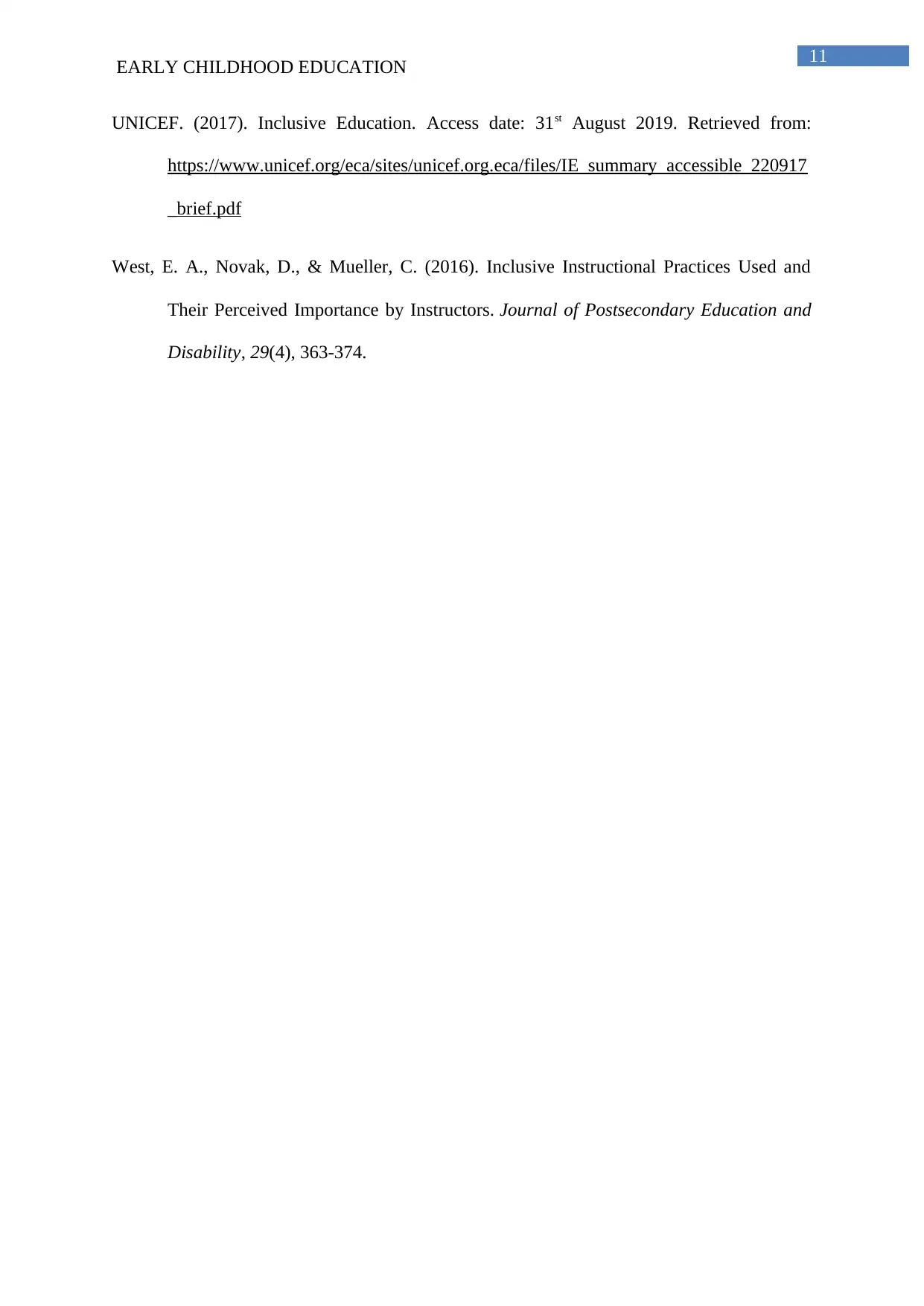
11
EARLY CHILDHOOD EDUCATION
UNICEF. (2017). Inclusive Education. Access date: 31st August 2019. Retrieved from:
https://www.unicef.org/eca/sites/unicef.org.eca/files/IE_summary_accessible_220917
_brief.pdf
West, E. A., Novak, D., & Mueller, C. (2016). Inclusive Instructional Practices Used and
Their Perceived Importance by Instructors. Journal of Postsecondary Education and
Disability, 29(4), 363-374.
EARLY CHILDHOOD EDUCATION
UNICEF. (2017). Inclusive Education. Access date: 31st August 2019. Retrieved from:
https://www.unicef.org/eca/sites/unicef.org.eca/files/IE_summary_accessible_220917
_brief.pdf
West, E. A., Novak, D., & Mueller, C. (2016). Inclusive Instructional Practices Used and
Their Perceived Importance by Instructors. Journal of Postsecondary Education and
Disability, 29(4), 363-374.
⊘ This is a preview!⊘
Do you want full access?
Subscribe today to unlock all pages.

Trusted by 1+ million students worldwide
1 out of 13
Related Documents
Your All-in-One AI-Powered Toolkit for Academic Success.
+13062052269
info@desklib.com
Available 24*7 on WhatsApp / Email
![[object Object]](/_next/static/media/star-bottom.7253800d.svg)
Unlock your academic potential
Copyright © 2020–2025 A2Z Services. All Rights Reserved. Developed and managed by ZUCOL.




